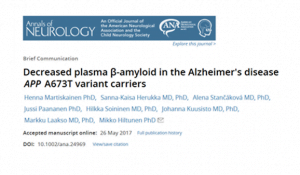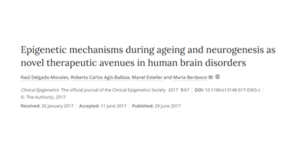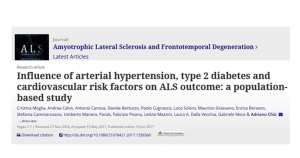 „Decreased plasma β-amyloid in the Alzheimer’s disease APP A673T variant carriers” has been published in the journal Annals of Neurology. This work was supported in part by JPND through the EADB project, selected in the 2015 JPco-fuND call.
„Decreased plasma β-amyloid in the Alzheimer’s disease APP A673T variant carriers” has been published in the journal Annals of Neurology. This work was supported in part by JPND through the EADB project, selected in the 2015 JPco-fuND call.
Monthly Archives: július 2017
Working with mouse, fly and human cells and tissue, researchers report new evidence that disruptions in the movement of cellular materials in and out of a cell’s control center — the nucleus — appear to be a direct cause of brain cell death in Huntington’s disease, an inherited adult neurodegenerative disorder. Moreover, they suggest, laboratory experiments with drugs designed to clear up these cellular „traffic jams” restored normal transport in and out of the nucleus and saved the cells.
In the study, published in Neuron, the researchers also conclude that potential treatments targeting the transport disruptions they identified in Huntington’s disease neurons may also work for other neurodegenerative diseases, such as ALS and forms of dementia.
In an earlier study, the team found out how a mutation in a gene — implicated in 40 percent of inherited ALS cases and 25 percent of inherited frontotemporal dementia cases — gums up transport in and out of the nucleus in neurons, ultimately shutting the cell down and leading to its death. The mutant gene makes RNA molecules that stick to a transport protein, RanGAP1. RanGAP1 in turn helps move molecules through nuclear pores that serve as passageways in the nucleus, letting proteins and genetic material flow in and out of it. They learned that this same mutation is also the most common cause of another disorder in which patients have Huntington’s-like symptoms without having the causative Huntington’s disease mutation. Additionally, they realized that other researchers previously showed that mutations in the nuclear pore protein NUP62 caused Huntington’s disease-like pathology. Because of such clues from others’ research, the scientists took on the task of investigating whether problems with nuclear transport and the nuclear pores also happened in neurons with Huntington’s disease.
The researchers used two mouse models of Huntington’s disease: one with a human version of the mutant Huntingtin protein and another with an aggressive form of the disease that contains only the first portion of the mouse Huntingtin protein. By using antibodies with glowing markers that bind to specific proteins and viewing the neurons under the microscope, they saw that the mutant Huntingtin protein clumped up in the same location of the cell as abnormal clumps of RanGAP1, the nuclear transport protein. It also clumped up in the same location as abnormal clumps of nuclear pore proteins NUP88 and NUP62.
They also observed this same clumping of Huntingtin protein with RanGAP1 and nuclear pore proteins to the wrong place in the cell in brain tissue and cultured brain cells derived from deceased patients with Huntington’s disease.
To further explore nuclear transport’s role in Huntington’s disease, the team took lab-grown mouse neurons and used chemical switches to a) turn on both an additional healthy copy of the RanGAP1 gene and a mutant version of Huntingtin; b) just turn on the mutant Huntingtin; or c) just turn on a healthy version of Huntingtin.
They then measured cell death and found that neurons with the healthy version of Huntingtin had about 17 percent of the neurons die off. Neurons with only the mutant version of Huntingtin were more likely to die, with about 33 percent dying off, but in neurons with both the mutant Huntingtin and the RanGAP1, only 24 percent of the neurons died off. The researchers think that some of the extra healthy RanGAP1 they introduced into diseased cells wasn’t bound up to the mutant Huntingtin and resumed normal nuclear transport.
Next, they looked at cell death in cultured neurons with a healthy or a mutant form of Huntingtin, or with a mutant form of Huntingtin that was treated with small amounts of an experimental drug called KPT-350, one that prevents a nuclear export protein, Exportin-1, from shuttling proteins and RNA out of the nucleus. Neurons with the healthy version of Huntingtin had about 18 percent die off, and neurons with the mutant version of Huntingtin had about 38 percent die off. Those treated with the nuclear export blocking drug had improved survival, with only about 22 percent of the cells die off. Blocking nuclear export seemed to prevent cells from dying and counteracted the defects in neurons with mutant Huntingtin.
According to the researchers, there is an average of 2000 nuclear pores per cell and each individual nuclear pore consists of multiple copies of more than 30 different proteins that each serve different functions. It may be that nuclear pores on neurons and other types of brain cells like glia are constructed of different combinations of these proteins, some of which may be more or less critical in various neurodegenerative diseases.
The team of researchers is currently working on answering this question using a new mouse model that will allow them to isolate these nuclear pore proteins from different cell types in the mouse brain to identify whether these nuclear pore components are in fact different based on brain cell types and brain locations.
Paper: “Mutant Huntingtin Disrupts the Nuclear Pore Complex”
Reprinted from materials provided by Johns Hopkins Medicine.
A team of researchers has found a way to measure tau levels in the blood. The method accurately reflects levels of tau in the brain that correlate with neurological damage. The study, in mice and a small group of people, could be the first step toward a noninvasive test for tau.
The study was published in Science Translational Medicine.
The researchers say that such a test potentially could be used to quickly screen for tau-based diseases, monitor disease progression and measure the effectiveness of treatments designed to target tau.
Tau is a normal brain protein involved in maintaining the structure of neurons. But when tau forms tangles, it damages and kills nearby neurons. A blood-based screening test, likely years away, would be a relatively easy way to identify people whose symptoms may be due to problems with tau, without subjecting them to potentially invasive, expensive or complicated tests.
In the brain, most tau proteins are inside cells, some are in tangles, and the remainder float in the fluid between cells. Such fluid constantly is being washed out of the brain into the blood, and tau comes with it. However, the protein is cleared from the blood almost as soon as it gets there, so the levels, while detectable, typically remain very low.
The team reasoned that if they could keep tau in the blood longer, the protein would accumulate to measurable levels. Allowing the protein to accumulate before measuring its levels would magnify – but not distort – differences between individuals, in the same way that enlarging a picture of a grain of sand alongside a grain of rice does not change the relative size of the two, but does make it easier to measure the difference between them.
The researchers injected a known amount of tau protein directly into the veins of mice and monitored how quickly the protein disappeared from the blood. The researchers showed that half the protein normally disappears in less than nine minutes. When they added an antibody that binds to tau, the half-life of tau was extended to 24 hours.
To determine whether the antibody could amplify tau levels in an animal’s blood high enough to be measured easily, they injected the antibody into mice. Within two days, tau levels in the mice’s blood went up into the easily detectable range. The antibody acted like a magnifying glass, amplifying tau levels so that differences between individuals could be seen more easily.
Tau levels in people’s blood also rose dramatically in the presence of the antibody. The researchers administered the antibody to four people with a tau disease known as progressive supranuclear palsy. Their blood levels of tau rose 50- to 100-fold within 48 hours.
Measuring tau levels in the blood is only useful if it reflects tau levels in the brain, where the protein does its damage, the researchers said.
Both high and low levels of tau in the fluid that surrounds the brain could be a danger sign. Alzheimer’s and chronic traumatic encephalopathy both are associated with high levels of soluble tau, whereas progressive supranuclear palsy and other genetic tau diseases are thought to be associated with low levels.
To see whether elevated brain tau is reflected in the blood, the researchers treated mice with a chemical that injures neurons. The chemical causes tau to be released from the dying neurons, thereby raising tau levels in the fluid surrounding the cells. The scientists saw a corresponding increase of tau in the blood in the presence of the anti-tau antibody.
Paper: „Anti-tau antibody administration increases plasma tau in transgenic mice and patients with tauopathy”
Reprinted from materials provided by Washington University School of Medicine.
 „Epigenetic mechanisms during ageing and neurogenesis as novel therapeutic avenues in human brain disorders” has been published in the journal Clinical Epigenetics. This work was supported in part by JPND through the EPI-AD project, selected in the 2015 JPco-fuND call.
„Epigenetic mechanisms during ageing and neurogenesis as novel therapeutic avenues in human brain disorders” has been published in the journal Clinical Epigenetics. This work was supported in part by JPND through the EPI-AD project, selected in the 2015 JPco-fuND call.
 „Influence of arterial hypertension, type 2 diabetes and cardiovascular risk factors on ALS outcome: a population-based study„ has been published in the journal Amyotrophic Lateral Sclerosis and Frontotemporal Degeneration. This work was supported in part by JPND through the STRENGTH project, selected in the 2012 Risk Factors call, and the SOPHIA project, selected in the 2011 Biomarkers call.
„Influence of arterial hypertension, type 2 diabetes and cardiovascular risk factors on ALS outcome: a population-based study„ has been published in the journal Amyotrophic Lateral Sclerosis and Frontotemporal Degeneration. This work was supported in part by JPND through the STRENGTH project, selected in the 2012 Risk Factors call, and the SOPHIA project, selected in the 2011 Biomarkers call.
A team of researchers has identified silent, seizure-like activity in the hippocampus, a brain structure significantly affected in Alzheimer’s Disease, in two patients with Alzheimer’s disease and no known history of seizures. These alterations in the brain’s electrical activity could not be detected by standard EEG readings taken on the scalp and primarily occurred during sleep, a time when the preceding day’s memories are consolidated. The report was published in Nature Medicine.
The investigators describe two patients — both women in their 60s — who had developed symptoms suggestive of Alzheimer’s disease, such as confusion and repeatedly asking the same questions. Brain imaging studies and cerebrospinal fluid analysis for both patients were consistent with Alzheimer’s disease. It is common for patients with Alzheimer’s to experience fluctuations in their symptoms, but in both of these patients, those fluctuations were more exaggerated than typically seen.
While scalp EEG recordings did not reveal seizure-like activity, the investigators suspected that there may be undetected seizures within the hippocampus. They decided to try a more direct way of monitoring electrical activity in the hippocampus and related structures. Electrodes were placed adjacent to those structures on both sides of the brain through the foramen ovale (FO), naturally occurring openings at the base of the skull. Each patient’s brain activity was monitored simultaneously with both implanted electrodes and with scalp EEG for more than 24 to 72 hours.
In one patient, the FO electrodes revealed frequent bursts of electrical activity called spikes, often associated with seizures, most which were not detectible by scalp EEG. During a 12-hour period she experienced three seizures, all taking place during sleep but not producing any visible symptoms. Treatment with an anti-seizure medication eliminated the seizure-like activity, and in the following year, she experienced only one episode of confusion, which occurred after she missed several doses of her anti-seizure medication. FO electrode recording in the other patient also revealed frequent spiking during sleep, but anti-seizure treatment had to be discontinued because of adverse effects on her mood.
Since there is evidence that higher levels of neuronal activity can increase the production and deposition of Alzheimer’s associated proteins such as tau and amyloid-beta, understanding whether seizure-like activity accelerates the progression of Alzheimer’s disease will likely be a high priority for the researchers.
Paper: “Silent hippocampal seizures and spikes identified by foramen ovale electrodes in Alzheimer’s disease”
Reprinted from materials provided by Massachusetts General Hospital.
 „Point mutations in transactive response DNA-binding protein 43 (TDP-43)’s N-terminal domain compromise its stability, dimerization and functions „ has been published in the Journal of Biological Chemistry. This work was supported in part by JPND through the RiMod-FTD project, selected in the 2012 Risk Factors call.
„Point mutations in transactive response DNA-binding protein 43 (TDP-43)’s N-terminal domain compromise its stability, dimerization and functions „ has been published in the Journal of Biological Chemistry. This work was supported in part by JPND through the RiMod-FTD project, selected in the 2012 Risk Factors call.
Working with human brain tissue samples and genetically engineered mice, researchers report that consequences of low levels of the protein NPTX2 in the brains of people with Alzheimer’s disease (AD) may change the pattern of neural activity in ways that lead to the learning and memory loss that are hallmarks of the disease.
This discovery, published in the journal eLife, may one day help experts develop new and better therapies for Alzheimer’s and other forms of cognitive decline.
Clumps of proteins called amyloid plaques, long seen in the brains of people with AD, are often blamed for the mental decline associated with the disease. But autopsies and brain imaging studies reveal that people can have high levels of amyloid without displaying symptoms of AD, calling into question a direct link between amyloid and dementia.
This new study shows that when the protein NPTX2 is „turned down” at the same time that amyloid is accumulating in the brain, circuit adaptations that are essential for neurons to „speak in unison” are disrupted, resulting in a failure of memory.
„Immediate early genes” are a set of genes that are activated almost instantly in brain cells when people and other animals have an experience that results in a new memory. The gene NPTX2 is one of these immediate early genes that gets activated and makes a protein that neurons use to strengthen „circuits” in the brain.
Intrigued by previous studies indicating altered patterns of activity in brains of individuals with Alzheimer’s, the researchers wondered whether altered activity was linked to changes in immediate early gene function.
To get answers, they first turned to a library of 144 archived human brain tissue samples to measure levels of the protein encoded by the NPTX2 gene. NPTX2 protein levels, they discovered, were reduced by as much as 90 percent in brain samples from people with AD compared with age-matched brain samples without AD. By contrast, people with amyloid plaques who had never shown signs of AD had normal levels of NPTX2. This was an initial suggestion of a link between NPTX2 and cognition.
To study how lower-than-normal levels of NPTX2 might be related to the cognitive dysfunction of AD, the researchers examined mice bred without the rodent equivalent of the NPTX2 gene.
Tests showed that a lack of NPTX2 alone wasn’t enough to affect cell function as tested in brain slices. But then the researchers added to mice a gene that increases amyloid generation in their brain. In brain slices from mice with both amyloid and no NPTX2, fast-spiking interneurons could not control brain „rhythms” important for making new memories. Moreover, a glutamate receptor that is normally expressed in interneurons and essential for interneuron function was down-regulated as a consequence of amyloid and NPTX2 deletion in mouse and similarly reduced in human AD brain.
The researchers say the results suggest that the increased activity seen in the brains of AD patients is due to low NPTX2, combined with amyloid plaques, with consequent disruption of interneuron function. And if the effect of NPTX2 and amyloid is synergistic — one depending on the other for the effect — it would explain why not all people with high levels of brain amyloid show signs of AD.
The scientists then examined NPTX2 protein in the cerebrospinal fluid (CSF) of 60 living AD patients and 72 people without AD. Lower scores of memory and cognition on standard AD tests, they found, were associated with lower levels of NPTX2 in the CSF. Moreover, NPTX2 correlated with measures of the size of the hippocampus, a brain region essential for memory that shrinks in AD. In this patient population, NPTX2 levels were more closely correlated with cognitive performance than current best biomarkers — including tau, a biomarker of neurodegenerative diseases, and a biomarker known as A-beta-42, which has long been associated with AD. Overall, NPTX2 levels in the CSF of AD patients were 36 to 70 percent lower than in people without AD.
According to the researchers, NPTX2 could constitute a new mechanism that has not previously been studied in animal models, and for this reason could lead to exciting new discoveries. More work is needed, they say, to understand why NPTX2 levels become low in AD and how that process could be prevented or slowed.
Paper: “NPTX2 and cognitive dysfunction in Alzheimer’s Disease”
Reprinted from materials provided by Johns Hopkins Medicine.
